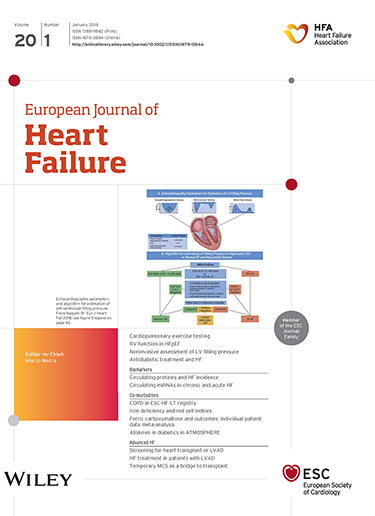A simplified approach for diagnosing heart failure with preserved ejection fraction by assessing the left atrium and natriuretic peptides
IF 10.8
1区 医学
Q1 CARDIAC & CARDIOVASCULAR SYSTEMS
引用次数: 0
Abstract
AimsHeart failure with preserved ejection fraction (HFpEF) is common but diagnosing it remains cumbersome and complex. Left atrial (LA) enlargement and dysfunction is an important pathologic marker in HFpEF. We evaluated whether LA measures and circulating natriuretic peptides (NPs) could simplify HFpEF diagnosis as a first step.Methods and resultsA new, first‐step diagnostic approach to rule in HFpEF is presented using LA volume indexed for height通过评估左心房和利钠肽来保留射血分数诊断心力衰竭的简化方法
目的保留射血分数(HFpEF)的心力衰竭是常见的,但诊断仍然繁琐和复杂。左房增大和功能障碍是HFpEF的重要病理标志。我们评估了LA测量和循环利钠肽(NPs)是否可以作为简化HFpEF诊断的第一步。方法和结果提出了一种新的、第一步诊断HFpEF规则的方法,使用LA体积索引高度2 (LAViH2;窦性心律(35.5 ml/m2)或房颤(38.6 ml/m2)和NPs(根据HFA - PEFF主要标准)。LA/NP方法来源于443例疑似HFpEF患者(最终诊断为84% HFpEF, 16%对照组无心力衰竭),并在两个独立队列中验证(503例患者,90% HFpEF;123例(运动)右心导管,86% HFpEF)。LA/NP步骤确定了60%的HFpEF患者,特异性为88%,阳性预测值(PPV)为97%(衍生队列)。依次应用LA/NP步骤,如果正常,然后使用HFA - PEFF或H2FPEF算法,与开始使用算法相比,降低了中间HFpEF的可能性得分,将HFpEF诊断的额外诊断需求减少了27% (HFA - PEFF)和56% (H2FPEF)。验证队列证实了LA/NP方法(76-80%特异性,92-97% PPV,中间评分降低21-57%)。用LA储层菌株替代LAViH2效果相当。结论采用增大LA容积和升高NPs的第一步方法可简化HFpEF的诊断。该方法识别大多数HFpEF患者具有高特异性,并通过降低中间HFA - PEFF或H2FPEF评分,大大减少了额外诊断的需要。
本文章由计算机程序翻译,如有差异,请以英文原文为准。
求助全文
约1分钟内获得全文
求助全文
来源期刊

European Journal of Heart Failure
医学-心血管系统
CiteScore
27.30
自引率
11.50%
发文量
365
审稿时长
1 months
期刊介绍:
European Journal of Heart Failure is an international journal dedicated to advancing knowledge in the field of heart failure management. The journal publishes reviews and editorials aimed at improving understanding, prevention, investigation, and treatment of heart failure. It covers various disciplines such as molecular and cellular biology, pathology, physiology, electrophysiology, pharmacology, clinical sciences, social sciences, and population sciences. The journal welcomes submissions of manuscripts on basic, clinical, and population sciences, as well as original contributions on nursing, care of the elderly, primary care, health economics, and other related specialist fields. It is published monthly and has a readership that includes cardiologists, emergency room physicians, intensivists, internists, general physicians, cardiac nurses, diabetologists, epidemiologists, basic scientists focusing on cardiovascular research, and those working in rehabilitation. The journal is abstracted and indexed in various databases such as Academic Search, Embase, MEDLINE/PubMed, and Science Citation Index.
 求助内容:
求助内容: 应助结果提醒方式:
应助结果提醒方式:


